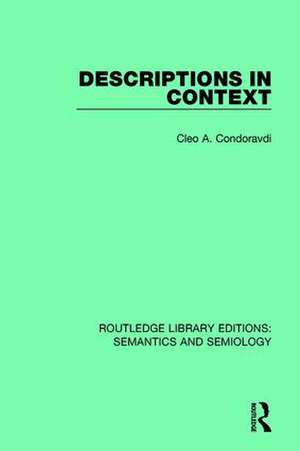Descriptions in Context: Routledge Library Editions: Semantics and Semiology
Autor Cleo A. Condoravdien Limba Engleză Paperback – 27 feb 2018
| Toate formatele și edițiile | Preț | Express |
|---|---|---|
| Paperback (1) | 251.32 lei 6-8 săpt. | |
| Taylor & Francis – 27 feb 2018 | 251.32 lei 6-8 săpt. | |
| Hardback (1) | 513.61 lei 6-8 săpt. | |
| Taylor & Francis – 4 oct 2016 | 513.61 lei 6-8 săpt. |
Preț: 251.32 lei
Nou
Puncte Express: 377
Preț estimativ în valută:
48.10€ • 52.22$ • 40.40£
48.10€ • 52.22$ • 40.40£
Carte tipărită la comandă
Livrare economică 22 aprilie-06 mai
Preluare comenzi: 021 569.72.76
Specificații
ISBN-13: 9781138697416
ISBN-10: 1138697419
Pagini: 216
Ilustrații: Illustrations, black and white
Dimensiuni: 156 x 234 x 12 mm
Greutate: 0.45 kg
Ediția:1
Editura: Taylor & Francis
Colecția Routledge
Seria Routledge Library Editions: Semantics and Semiology
Locul publicării:Oxford, United Kingdom
ISBN-10: 1138697419
Pagini: 216
Ilustrații: Illustrations, black and white
Dimensiuni: 156 x 234 x 12 mm
Greutate: 0.45 kg
Ediția:1
Editura: Taylor & Francis
Colecția Routledge
Seria Routledge Library Editions: Semantics and Semiology
Locul publicării:Oxford, United Kingdom
Cuprins
Preface; Introduction; 2 Bare Plurals and Genericity; 1 Introduction 2 Genericity and the Readings of Bare Plurals 2.1 Genericity 2.2 Bare Plurals 3 The Kind Analysis 3.1 Basic Outline 3.2 Arguments for a Unified Treatment 3.2.1 Bare Plurals Are Unambiguous 3.2.2 Bare Plurals and Indefinite NP’s 3.2.3 A Generic Operator and Bare Plurals 3.3 Limits and Limitations of Uniformity 3.4 Summary 4 The Indefiniteness Analysis 4.1 Basic Outline 4.2 Individual-Level and Stage-Level Predicates 4.3 The Generic Operator 4.3.1 Implicit Domain Restrictions 4.3.2 Modal Dimension 4.4 Conclusion Appendix Notes; 3 Functional Reading of Bare Plurals; 1 Introduction 2 The Functional Reading of Bare Plurals 2.1 Initial Observations 2.2 Functional Reading with Individual-Level Predicates 2.2.1 Genericity and the Functional Reading 2.2.2 Contextual Restrictions 2.3 Functional Reading with Stage-Level Predicates 2.4 Other Indefinites 2.5 Excluding a Purely Pragmatic Account 2.5.1 The Implicature 2.5.2 The Referentiality Approach 2.6 Functional Reading in Quantified Contexts 2.6.1 Dependent Functional Reading 2.6.2 Quantificational and Modal Subordination 2.7 The Presupposition of Existence 2.7.1 Simple Cases 2.7.2 Projection of the Existential Presupposition 2.7.3 Functional Reading with Adverbs of Quality 2.8 Overview 3 An Operator Analysis 3.1 Degenerative Genericity 3.2 Degenerative Genericity and the Functional Reading 3.2.1 Implicit Contextual Restrictions 3.2.2 Implication of Existence 3.2.3 Scopal Interaction 3.3 Stage-Level 3.4 Positive Contextual Sensitivity 3.5 Summary 4 Conclusion Notes; 4 Strong and Weak Novelty; 1 Introduction 2 The Dynamic View on Meaning 2.1 Assertions and Contextual Update 2.2 Presuppositions and Contextual Admittance 3 The Novelty-Familiarity Theory of Definiteness 3.1 Files as Information States 3.2 Informativeness of Files 3.3 The Felicity Conditions of Definites and Indefinintes 3.4 The Truth Conditions for Definites and Indefinintes 4 The Functional reading 4.1 Weakly and Strongly Novel NP’s 4.2 Contextually Salient Functions 4.3 Negative Contextual Sensitivity 4.4 Strong and Weak Novelty and NP Strength 4.5 Existential Force and Strong vs. Weak Novelty 4.6 Maximality 4.7 Consequences of the Existential Presupposition 4.7.1 Positive Contextual Sensitivity 4.7.2 Dependent Functional Reading 5 Conclusion Notes; Bibliography; Index
Descriere
First published in 1997, this book focuses on the semantics of definite and indefinite descriptions — taking the presuppositional theory of definiteness and indefiniteness proposed by Heim as a starting point. It seeks to show that there exists a special type of indefinites that have an interpretation commonly associated with definites. It further argues that the felicity conditions associated with indefinite NP’s can vary and develops a more fine-grained theory of novelty within the framework of File Change Semantics. More generally, this work can be seen as providing an empirical argument in favour of a dynamic theory of meaning and against the more traditional truth-conditional theory.














